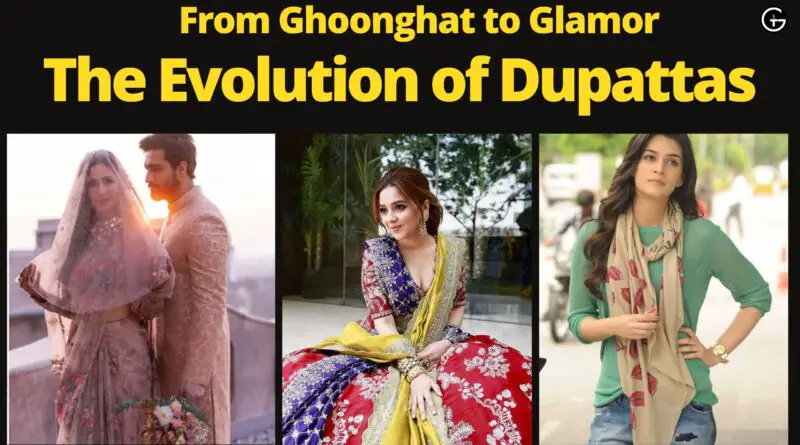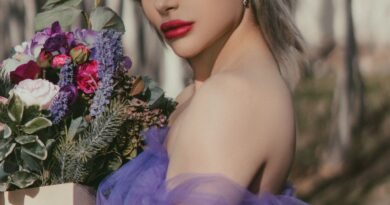From Ghoonghat To Glamor–The Evolution of Dupattas
Once used as a head veil to emphasize the modesty of a woman is now a piece of accessory that resides within itself the power to glam up any outfit with one stroke. Dupattas were dressed as Ghoonghat or head veils by women in the history of Indian culture. They then evolved to be a necessary element of an ethnic outfit. And today, we stand at a point where we can turn them into a scarf, a stole, a headband, a multi- purpose top, a blouse, and into a jacket with just attaching a single pin. Well, yes! I am serious. It is coming from my hours of scrolling YouTube videos on “How to style a dupatta?”
“No element of fashion drops off completely. It just changes forms, maybe shapes, sizes, colours, or silhouettes. But, dupattas are not going anywhere,” said my 50-year-old mother when I asked her over a cup of tea if dupattas were going to die soon. Interestingly, a homemaker made a statement that matched the opinions of popular couturiers in the industry. Several fashion designers opine that dupattas will continue to dazzle in more creative prints, styles, lengths, fabrics, detailing, and so on, allowing versatility in styling over the years.
Indian fashion designer Ritu Kumar says, “Dupattas are now a versatile piece of clothing. The prints, detailing, colours, etc have become a lot more vibrant allowing versatility in styling as well. From simple cotton to now a variety including silk, organza, Chanderi, even the fabrics have evolved.”
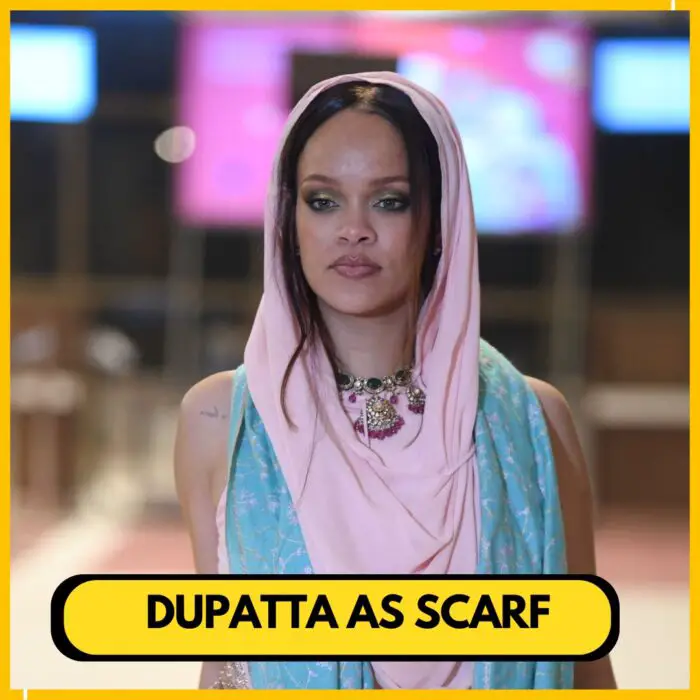
Evolution of Dupattas
One of the key things that have changed about dupattas over the years has been their length. Director of Kalki Fashion Nishit Gupta touches on this important point and says, “A dupatta was a long drape that is now shortened to only 2 meters for fashion purposes. Earlier, used as a cover-up but is now majorly seen as an accessory to add on a lehenga choli, sharara or salwar kameez to jazz up the ethnic look.” Diving deep into the detailing of dupattas, online fashion store Karmaplace founder Sasha Revankar explains, “It’s very common nowadays for the dupatta to have more intricate work like embroidery, beading or gold trim, than the outfit itself. A popular style we see is a very simple kurta set with a dazzling saree-like dupatta hanging on the shoulder. For a more casual accessory, we see a lot of cotton dupattas with bold colours and prints that accessorize well with western and traditional clothing. The amount of variety in dupattas is quite intense, from tiger prints to shawl-like pashmina – you can say they look like a piece of art draped over the shoulder.”
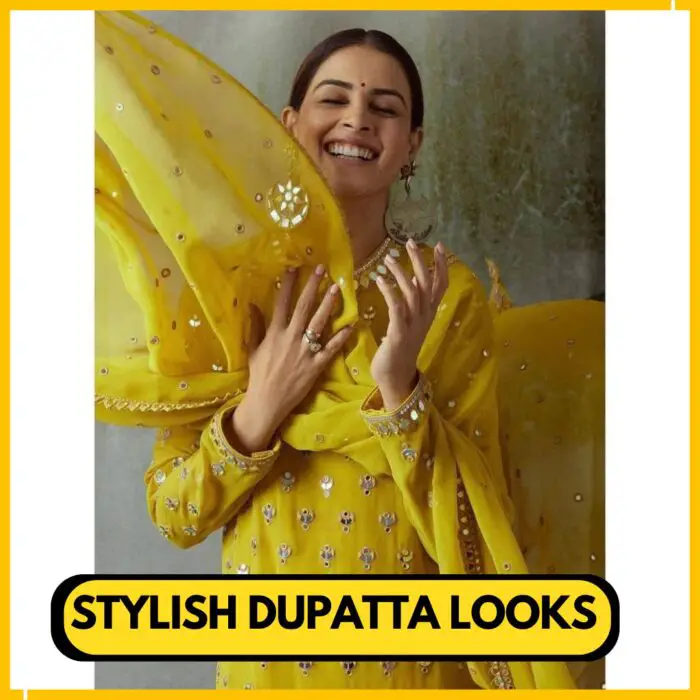
While each one has their own wonderful versions of keeping dupattas alive, it should be noted that from a common woman, a social media influencer, to the fashion biggies, everyone feel that dupattas are here to stay. Now, this leads to an important question– how to pick up a perfect dupatta to stand out? Well, you need not scroll through tons of YouTube videos or social media posts as I have got you covered.
Advising on shopping and styling a dupatta, Ritu Kumar says, “Look for prints and fabrics that compliment your existing wardrobe. A printed version not only goes well with a tone on tone suit which can be styled differently around your head as one would do with a scarf or around your neck like a stole. An embellished one works very well for formal Indian occasions to mix and match with Indian outfits.” Further she adds that quality should be the top priority while selecting a dupatta and we should look for fabrics that last and styles that are timeless. While Kumar emphasized on prints, the Kalki Fashion Director believes that fabrics like chikankari, bandhani, banarasi have a premium ethnic attraction. “Added to it to create more oomph are tassels, heavy borders and embroidery on desirable dupattas,” Gupta adds.
Bold Color Dupattas
Meanwhile, the Karmaplace founder says that bold color dupattas with artistic touch to them can be an addition to the traditional styles. “Fabric and sizing are the biggest considerations for me. Always go for fabric that is easy to maintain but also comfortable. Always double check the size charts and know your measurements,” he says making the selection process easier. With so many patterns in dupattas out there, I no longer feel like dropping this element from my outfit. While styling a dupatta on an Indian ensemble, the rule is basic—a heavily embroidered kurta set or lehenga will require a plane dupatta and an
embellished dupatta will make a simple suit stand out.
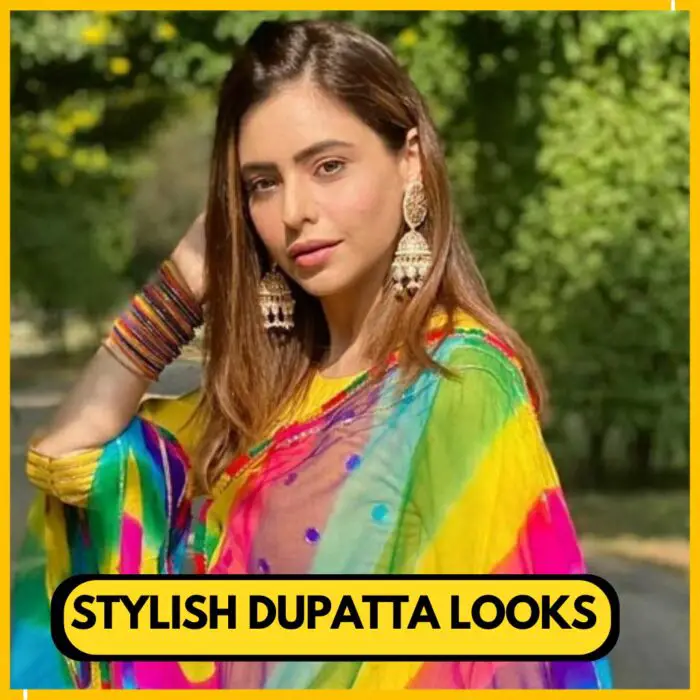
However, it should be noted that the entire Indian fashion industry has been evolved over the years. The trends have shifted from traditional to what they call it Indo-Western now. From styling it on one shoulder to wearing it like a high-low top over a lehenga, or
wrapping a dupatta with a belt, there are tons of different ways in which a dupatta can be styled. To my disbelief, fashion influencers take a scarf and drape it like a blouse with a skirt or a lehenga nowadays.
Dupattas in Every Season
While styling may remain constant, being seasonal is the very nature of fashion. Specifically for this season, Ritu Kumar advises going for cotton silk fabric suits and printed dupattas. “The simplicity of the suit and the printed dupatta makes it a great wardrobe style staple that can be styled up or down as per the occasion. The cotton silk fabric of the suits makes them perfect for all weathers as well,” she says. On the other hand, the Kalki director feels that this season is the time to up the sartorial game with artful intricate work and light weight dupattas.
“A riot of hues decked in artful intricate work and will take your Indian-ness to up the sartorial game. Soar high on fashion & light on weight, ideal drapes to wrap yourself in the monsoons. Get that Desi look but stylishly through the premium dupattas that we have solely brought for you to keep the distinct ethnic fashion quotient a notch higher,” Gupta says. Meanwhile, the Karmaplace founder feels it is time to play with bold colors and prints while accessorizing your outfits with dupattas maintaining that classic dupattas are not going anywhere.
Sharing an experience of a friend, Revankar says, “I think it’s good to have some classy dupattas in your closet since they can take up any outfit up a notch. A friend of mine was attending an Indian function and did not have Indian attire, she wore a sleeveless dress paired with a gold-trim dupatta – it was just stunning!”
Ah! With so many distinct views from the industry experts, I rest my case with the conclusion that dupattas are no longer only about highlighting your modesty in a Ghoonghat, they have rather evolved as an artistic element that adds oodles of glamour to your overall look.

